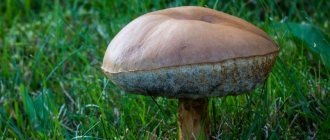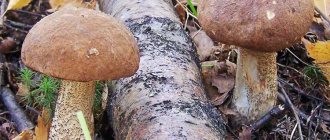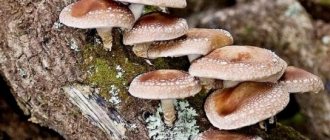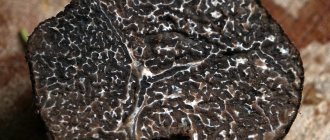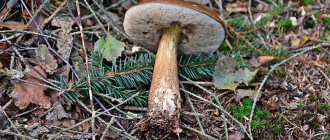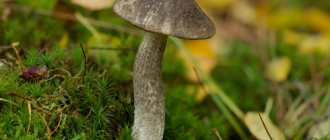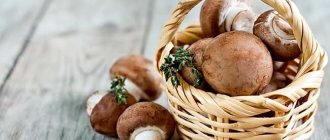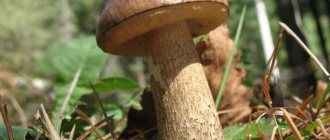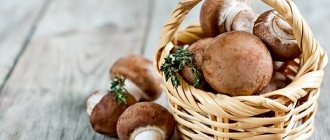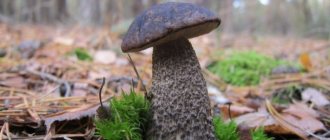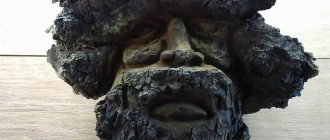Boletus mushrooms know everything. June boletuses are especially desirable, as they are the very first among the valuable tubular mushrooms. In June, when there are still few mosquitoes in the forest, it is pleasant to walk along the emerging green forest belt. At this time, they prefer the southern open sides of trees and small hills along canals and the banks of rivers and lakes. At this time, the following boletus mushrooms can most often be found:
- yellow-brown,
- ordinary,
- swamp.
In July, the number of boletus mushrooms increases sharply. Now they appear everywhere: in swampy places, next to paths, in clearings, under trees. Preference is given to mixed forests with birch and spruce trees.
Description and features of the mushroom
Boletaceae belong to the genus Leccinum or boletaceae of the Boletaceae family, which includes, in addition to the boletus boletus itself, also the boletus boletus. Forming mycorrhiza with birch, it is usually found near these trees. A characteristic appearance distinguishes boletus mushrooms from other mushrooms:
- The caps are convex, matte, dry. Diameter up to 15 cm.
- The color of the “head” varies from gray to black. There is a variety of mushroom that has a white cap.
- In young specimens the cap is white below, but with age it acquires a gray-brown tint.
- The stem of the boletus is light, slightly thickened (thickness up to 3 cm). It reaches a height of 15-17 cm. It has longitudinal dark scales.
- The flesh of the mushroom is white and does not change color when broken, with rare exceptions. Young specimens are dense and tender inside; when they grow, the flesh becomes loose.
Chemical composition of boletus
The benefits of boletus are due to the large amount of vitamins, fiber, easily digestible proteins and carbohydrates it contains, which it receives due to interaction with the roots of the tree. The nutritional qualities of the mushroom make it similar to meat. It also contains a complete set of amino acids necessary for humans. And in terms of mineral content, it is comparable to porcini mushroom, only slightly inferior to it.
The mushroom contains vitamins of groups C, PP, E, B1 and B2 and minerals such as:
- potassium - most of all;
- manganese – 37% of the daily value;
- calcium – 18% of the daily value;
- phosphorus;
- sodium;
- magnesium;
- iron.
The dense, fleshy part of the boletus mushroom is a source of coarse dietary fiber. Its value lies in its well-balanced protein.
The nutritional value of boletus is as follows:
- per 100 g of product – about 20 kcal;
- water – 90.1 g;
- fiber – 5.1 g;
- proteins – 2.3 g;
- carbohydrates – 1.2 g;
- fats – 0.9 g.
Marsh boletus, nut form (Leccinum nucatum)
HABITAT: singly and in groups in sphagnum bogs and in damp mixed forests with birches, near water bodies.
SEASON: from July to the end of September.
The cap is 3-10 cm in diameter, and in some cases up to 14 cm; in young mushrooms it is convex, cushion-shaped, then flatter, smooth or slightly wrinkled. A distinctive feature of the species is the nutty or creamy brown color of the cap.
The leg is thin and long, whitish or whitish-cream. The second distinctive property of the species is the large scales on the stalk, especially in young specimens, when the surface looks very rough and even lumpy.
Height - 5-13 cm, sometimes reaches 18 cm, thickness -1-2.5 cm.
The pulp is soft, white, dense, and has a light mushroom aroma. The hymenophore is whitish, becoming grayish over time.
The tubular layer is 1.2-2.5 cm thick, white in young specimens and dirty grayish later, with rounded angular pores of the tubules.
Variability : Cap color varies from hazel to light brown. Tubes and pores - from white to gray. The white leg darkens with age, becoming covered with brownish-gray scales.
There are no poisonous doubles . By the color of the cap, these boletus mushrooms are similar to the inedible gall mushrooms (Tylopilus felleus), whose flesh has a pinkish tint and a bitter taste.
Edible , 2nd category.
A story about the boletus for primary schoolchildren
Boletus mushrooms live up to their name - they really grow under birch trees both in the forest and under isolated trees in the field. The first boletuses appear early, in early June. At the end of September, these mushrooms can hardly be found in central Russia.
The common boletus has a cap measuring 10-15 cm in various shades of brown. In the northern regions, boletuses with almost black or grayish “marbled” caps are often found. The bottom of the cap is light gray or cream with brown spots. The leg is covered with fibrous scales.
The boletus boletus is a smaller and more “flimsy” mushroom. Its cap is cream or grayish in color, and in older mushrooms it sometimes takes on a greenish tint. The leg of the boletus boletus is thin, long, and the scales on it are lighter. Mushroom pickers usually collect only the youngest mushrooms of this species, which are not inferior in density to boletuses.
Unfortunately, boletus mushrooms age very quickly. The flesh becomes flabby, the stem becomes woody. Many insect larvae appear in mushrooms. They live inside the tubes and are not always noticeable. Old mushrooms are not collected.
The boletus pulp does not change color when cut. They can be dried and fried. Pickled young mushrooms are also good.
Similar articles:
A story about the Moss mushroom for children
Message about umbrella mushrooms, grade 3. The world
Report on boletus mushrooms, grade 3. The world
Message about porcini mushroom, 3rd grade. The world
Message about Raincoats mushrooms, 2nd grade. The world
No comments yet. Yours will be the first!
Marsh boletus, oxidizing form (Leccinum oxydabile)
HABITAT: singly and in groups in sphagnum bogs and in damp mixed forests with birches, near water bodies.
SEASON: from July to the end of September.
The cap is 3-8 cm in diameter, and in some cases up to 10 cm; in young mushrooms it is convex, cushion-shaped, then flatter, smooth or slightly wrinkled. A distinctive feature of the species is the color of the cap - whitish-cream with yellowish spots.
The leg is thin and long, whitish or whitish-cream, covered with gray-cream scales, which become gray-brown when dry. Height is 5-15 cm, sometimes reaches 18 cm, thickness is 1-2.5 cm. The second distinctive feature of the species is the ability to quickly oxidize, which is expressed by the appearance of pinkish spots when touched.
The pulp is soft, white, dense, has a slight mushroom aroma, and quickly turns pink when broken. The hymenophore is whitish, becoming grayish over time.
The tubular layer, 1.2-2.5 cm thick, is white in young specimens and dirty grayish later, with rounded angular pores of the tubules.
Variability: Cap color varies from white and light cream to pinkish cream. Tubes and pores - from white to gray. The white leg darkens with age, becoming covered with brownish-gray scales.
There are no poisonous counterparts, but from a distance, by the color of the cap, this boletus can be confused with the deadly poisonous white form of the pale grebe (Amanita phalloides), which, upon closer examination, is sharply distinguished by the presence of a ring on the stalk and a volva at the base.
Edible, category 2.
The value of boletus
In terms of value, boletus ranks second after boletus, the “king of mushrooms.” It is eaten in any form: boiled, fried, dried, pickled. Obabki are well preserved for the winter in dried or salted form. Subsequently, sauces, fillings for pies and just snacks are obtained from the preparations. It is advisable to choose young mushrooms from the forest, especially for pickling.
Boletus is a rare example of a mushroom that is useful to everyone without exception. In rare cases, one can talk about intolerance to mushroom cultures, only then it is not recommended to eat mushrooms. It brings only benefits to the rest. The dietary fiber of the pulp, entering the stomach, acts as an absorbent. They collect all harmful particles from digested food and remove them naturally. Due to the content of large amounts of potassium and phosphorus, the mushroom is useful in that it improves the functioning of the kidneys and adrenal glands, and also regulates blood sugar levels.
The benefits of obobka are as follows:
- Clears away toxins.
- Good for the skin.
- Normalizes the functioning of internal organs (liver and kidneys).
- Improves the structure of enzymes.
- Enriches with useful elements.
You can eat it while on a diet. Boletus, like any mushroom, is a good meat substitute. But it is advisable to make soups from it, less often - fry it and not eat it in salted form. An ideal option for dietary nutrition is mushroom pie, stew or boletus sauce, used as an addition to other dishes.
Useful properties of boletus mushrooms
The boletus mushroom is not only tasty, but also a useful mushroom from a medical point of view. Being a low-calorie product containing essential microelements, it is suitable for dietary nutrition. The boletus mushroom has a beneficial effect on the nervous system and regulates blood sugar. Eating it helps remove toxins from the body and improves kidney function.
The boletus mushroom is not poisonous, but if there is individual intolerance, allergic reactions may occur. Having eaten mushrooms that have been stored for a long time in unsuitable containers, you can become poisoned - high fever and vomiting appear.
Types of mushrooms and their growth
Boletus mushrooms are common mushrooms that come in several varieties. There are four main ones: ordinary, black, white or swamp, pinkish. Other varieties are less popular. They are combined into a common group or called close relatives with the common boletus and its relatives (presented above). This is due to the fact that they differ in appearance, distribution area and even taste.
Common boletus
The most valuable (from a culinary point of view) representative of the species and the best in taste. It has all the advantages of an edible mushroom. The appearance is classic for boletus: the leg is strong, may have a thickening at the bottom, the cap is smooth, brown, and shaped like a hemisphere. It is uniformly colored, ranging from light gray to dark brown. The color depends on the growing conditions, as well as the type of tree with which the mycorrhiza is formed. It doesn't have to be birch.
The mushroom grows on the edges, clearings, birch forests, and among young trees. As a rule, it chooses mixed forests; in some years the yield is high - the mushroom is found in large quantities. Often boletus can be found in spruce plantings interspersed with birch trees. Mushroom pickers “hunt” the common boletus from the beginning of the summer season until late autumn.
Black birch
Its other name is blackhead. The mushroom is distinguished by a darker, brown cap, smaller in diameter than the ordinary one. With age, the cap becomes even darker. Its surface is dry, but after rain it becomes slimy. The length of the leg is about 12 cm, dark scales appear on it. The pulp is firm and acquires a bluish tint when cut. The tubes are large, dirty white or gray in color.
Blackheads are a rarer type of mushroom compared to their relatives. They prefer to grow in damp places: along the edges of swamps, in pine forests, thick grass, and do not shy away from birch forests. They grow from August to November - this is a late variety of mushrooms. In terms of taste, the dun cap is not inferior to the common boletus. Finding it in the forest is the joy of a mushroom picker.
White (marsh) boletus
The distribution area of this fungus is swampy areas, mossy darkened forests, and flooded birch forests. Hence the name - swamp. Outwardly it differs from its relatives with a light, almost white cap. In young specimens it has the shape of a hemisphere; with age it becomes more prostrate, but does not open completely. White scales appear on it, which darken as they dry.
The skin and pulp may have a greenish tint, and the spore powder is ocher in color. The leg turns blue downwards. The pulp is loose and breaks easily. It does not have a strong odor or color. In terms of taste, the boletus is inferior to the common boletus - it is more watery and inconspicuous. The mushroom is found quite often, but is not very productive. Mushroom pickers find marsh boletus from mid-summer to October.
Pink boletus
The pink or oxidizing representative of the ape differs from its relatives by a low, thin leg, which tends to bend in the sunny direction. The cap is cushion-shaped, the skin is gray-brown to brown in color. The tubular layer is whitish, becoming dirty gray with age. When cut, the flesh does not darken, like everyone else’s, but turns slightly pink, acquiring a brick-pink hue. Hence the name.
The pinkish species is found in northern forests mainly in autumn. Grows in swampy areas, in birch forests in damp areas. As a rule, mushrooms are found in groups and grow separately. They form mycorrhiza with birch. Pink beetles are rare; they prefer peat bogs overgrown with moss or dense grass thickets. Mushroom pickers can find them along the way of collecting cranberries: around lakes, drying swamps, in damp forest depressions.
Gray boletus
Its other name is elm or hornbeam. The fungus, common in the Caucasus, forms mycorrhiza with hornbeams, trees from the birch family. But it can also be found under other deciduous trees - hazel, poplar, birch. Fruits from June to October. Externally, it is not very different from the common boletus.
The hornbeam's cap is olive-brown or brown-gray, with folded edges. Its surface is velvety and uneven. The skin of mature mushrooms sometimes shrinks, exposing the cap's flesh and porous layer. The pores of the fungus are very small, angular-round in shape. On the stem the flesh is fibrous and white, but when cut it becomes pinkish-violet, then gray, to almost black.
Ash gray dog
This type of boletus got its name from the color of the tubular layer at the bottom of the cap. If you cut the flesh, it will turn pink and turn blue or green at the base. The skin of the cap is light brown, becoming darker as the mushroom grows. The surface is smooth, the shape is convex. The leg is long and thin, whitish in color, but with loose dark scales. The ash-gray boletus is edible, but its taste is mediocre. Fruits in autumn.
Checkerboard or blackening boletus
This representative of the genus obabkov is found in beech forests or oak groves, forming mycorrhizae with these trees. Distributed in the Caucasus. The mushroom cap is yellow-brown, the tubular layer and spore powder are lemon yellow. In youth, the cap has the shape of a hemisphere, then it becomes cushion-shaped with a blunt edge. Its diameter is up to 15 cm. When cut, the pulp becomes dark (purple) and then turns black. The leg is cylindrical or club-shaped and thickened at the bottom.
Stiff boletus
The obabok is harsh, hard, poplar-like. It got its name because of the hard flesh of the mushroom. This has a positive effect on its taste. At the break, the flesh turns red and blue (in the upper and lower parts of the leg, respectively). The diameter of the cap is 6-15 cm. At first it is hemispherical, and later convex, sometimes with a depressed center in mature mushrooms. The skin is slightly pubescent when young, but becomes matte and smooth. The color of the cap is extremely variable. Young mushrooms have the same color as the flesh, the shade varies from gray-brown to ocher or reddish-brown.
Stiff-haired obabok grows in mixed forests, forming a symbiosis with aspen and poplars. Occurs singly or in rare groups. Selects calcareous and sandy soils, loam. This is a rare species of boletus, you need to go looking for it in the summer (from July) and autumn (it bears fruit until mid-November). Recently, the harsh little dog has been seen more and more often and in larger quantities.
Multi-colored obabok
The cap of this type of boletus is variegated, mouse-colored, as if shaded. The white flesh turns pink when cut, and turquoise on the stem. The pores of the tubular layer are creamy. The length of the stem depends on the height of the moss above which the mushroom needs to rise. It is light and thick. A blue tint may appear at the bottom of the leg. The scales are gray. The multi-colored species is similar to the common boletus, it also bears fruit and is found in the southern latitudes of our country. But this type of obabka is not in demand among mushroom pickers, as it is difficult to prepare and does not taste very good.
Yellow-brown boletus (Leccinum versipelle)
HABITAT: birch, coniferous and mixed forests.
SEASON: June to October.
The cap is fleshy, 5-15 cm in diameter, and in some cases up to 20 cm. The shape of the cap is hemispherical with a slightly woolly surface; with age it becomes less convex. Color - yellow-brown or bright orange. Often the skin hangs over the edge of the cap. The lower surface is finely porous, the pores are light gray, yellow-gray, ocher-gray.
The leg is thin and long, white, covered along its entire length with black scales; in immature specimens it is dark.
The pulp is dense, whitish, and turns gray-black when cut.
A tubular layer up to 2.5 cm thick with very small white pores.
Variability: the color of the cap varies from light brown to yellow-brown and dark brown. As the mushroom matures, the skin of the cap may shrink, exposing the surrounding tubes. The pores and tubes are first whitish, then yellow-gray. The scales on the leg are first gray, then almost black.
poisonous doubles . Similar to these boletus mushrooms are gall mushrooms (Tylopilus felleus), which have pinkish-tinged flesh and have an unpleasant odor and a very bitter taste.
Methods of preparation: drying, pickling, canning, frying. It is recommended to remove the stem and, in older mushrooms, the skin before use.
Edible , 2nd category.
Where and when to collect boletus mushrooms?
The distribution area of boletus mushrooms is quite wide. They are found throughout the country. Mushrooms prefer to grow in deciduous and deciduous-coniferous forests, birch forests, and can be found in parks and on the edges of young growth. Favorite places are the edges of clearings of mossy forests, the edges of ravines. Obabkas prefer calcareous soils, but are also found in other places.
Boletus mushrooms love warmth and, as a rule, grow where the soil is well warmed by the Sun.
The collection time for obabkov is the entire summer season, starting from the end of May and ending in October. The common boletus is found until the first frost. Mushrooms ripen at the same time as porcini mushrooms, perhaps a little earlier. Some species (depending on where they are distributed) appear first and last longer.
Boletus mushrooms are famous for their rapid growth. Over the course of a day, the mushroom can add up to 4 cm and up to 10 g of weight. But after 5-6 days it begins to age. Therefore, it is recommended to collect young specimens; they are tasty, crunchy and, as a rule, not wormy. Adult mushrooms are looser.
Brown boletus (Leccinum brunneum)
HABITAT: birch, coniferous and mixed forests.
SEASON: June to October.
The cap is fleshy, 5-14 cm in diameter, and in some cases up to 16 cm. The shape of the cap is hemispherical with a slightly woolly surface; with age it becomes less convex. A distinctive feature of the species is its brown cap with a reddish tint and a shiny surface. The lower surface is finely porous, the pores are creamy-gray, yellow-gray.
The leg is gray-cream in color, covered along its entire length with black scales; in mature specimens it is dark.
The pulp is dense, whitish, and turns gray-black when cut.
A tubular layer up to 2.5 cm thick with very small white pores.
Variability: the color of the cap varies from brown to brownish-brown. As the mushroom matures, the skin of the cap may change from sticky and shiny to drier and matte. The pores and tubes are first whitish, then yellow-gray. The scales on the leg are first gray, then almost black.
There are no poisonous doubles . A little similar to these boletus mushrooms are gall mushrooms (Tylopilus felleus), which have pinkish-tinged flesh and have an unpleasant odor and a very bitter taste.
Methods of preparation: drying, pickling, canning, frying. It is recommended to remove the stem and, for older mushrooms, the skin before use.
Edible, category 2.
How to identify false boletus
There are mainly 2 types of mushrooms disguised as tasty and healthy mushrooms: gall and pepper. They are not poisonous and will not cause harm, but they can significantly spoil the taste of the finished dish. Once there, even in small quantities, they will provide a bitter aftertaste to any culinary masterpiece.
Peppery
Gall
The gall mushroom can be distinguished from the boletus mushroom by the following characteristics:
- If the cap has a greenish tint, pass by this mushroom. The obobka does not have green in the color of his cap.
- The boletus mushroom is easily distinguished by its characteristic scales on the stalk; the gall mushroom does not have them; its pattern is replaced by a mesh.
- The tubular layer of the gall fungus has a subtle pink tint, especially on the inside. When damaged or pressed, the hymenophore becomes brown or reddish in color.
The pepper mushroom, which is similar to an obabok, also lacks scales on a thin stalk, is much smaller in size and grows mainly in coniferous areas.
Reference. Both gall and pepper mushrooms can be quite useful: the first has good medicinal potential, and the second, in small quantities, will serve as an excellent spicy seasoning.
Marsh boletus (Leccinum holopus)
HABITAT: singly and in groups in sphagnum bogs and in damp mixed forests with birches, near water bodies.
SEASON: from July to the end of September.
The cap is 3-10 cm in diameter, and in some cases up to 16 cm; in young mushrooms it is convex, cushion-shaped, then flatter, smooth or slightly wrinkled. A distinctive feature of the species is the color of the cap - whitish-cream, grayish-bluish, grayish-greenish.
The leg is thin and long, whitish or grayish, with whitish scales, which become brownish when dry. Height 5-15 cm, thickness 1-3 cm.
The pulp is soft, white, slightly greenish, watery, bluish-greenish at the base of the stem. The pulp does not change color when cut.
The tubular layer is 1.5-3 cm thick, white in young specimens and dirty grayish later, with rounded angular pores of the tubules.
Variability : The color of the cap varies from white and light cream to bluish-greenish. Tubes and pores - from white to brown. The white leg darkens with age, becoming covered with brownish scales.
There are no poisonous doubles . The size and shape of the cap are similar to the inedible gall mushrooms (Tylopilus felleus), whose flesh has a pinkish tint and a scalding bitter taste.
Edible , 2nd category.
Where and how to collect boletus mushrooms?
It is better to collect mushrooms in willow baskets or enamel buckets. It is not recommended to cut mushrooms growing in an uncharacteristic place. If you are not sure whether a mushroom belongs to the edible category, it is better not to touch it. You need to start processing the harvest immediately upon arriving home. The boletus mushroom is suitable for all types of culinary processing. It can be boiled, stewed, fried. To prepare for future use, boletus mushrooms are dried, pickled and frozen.
Did you like the article? Share with your friends:
Where do boletus mushrooms grow?
You can go collecting boletus mushrooms in any light deciduous and mixed forests, the main thing is that they have birch trees. These mushrooms can be found in North and South America, as well as in Eurasia. The boletus mushroom grows even in the harsh conditions of the tundra and forest-tundra, under dwarf birch trees. As soon as the bird cherry blossoms, mushroom pickers go to the forest. Mushroom hunting continues until mid-autumn. Due to the fact that boletus flowers love light, it is better to look for them on forest edges and open clearings.
Self-cultivation of boletus mushrooms
The famous boletus mushroom can be grown independently, on a garden plot or in a specially designated area, not only for personal use, but also for sale. The business is profitable and does not require much hassle. In addition, compared to other mushrooms, boletus mushrooms are famous for their high yield. You just need to properly care for the garden bed. It is better to plant mushrooms in May-June.
The most difficult thing is to obtain the mycelium of the fungus. Boletus mushrooms are distinguished by the fact that their spores are difficult to separate from the pulp. Knowing this, manufacturers of ready-made mycelium sell boletus substrate ready for planting. This saves the future farmer's time. The cost of a 60 ml package is small - up to 200 rubles. If it was not possible to obtain ready-made mycelium for planting, you need to prepare a mixture that will precipitate the mature spores.
How to germinate mushrooms naturally? First of all, you need to get the spores. They are contained in the mushroom pulp, which must be separated from the cap, minced through a meat grinder and placed in a container with water. Further scheme of action:
- Dry yeast is added to the mixture - a nutrient medium for the propagation of spores.
- The liquid is infused for a week. Then the foam is removed from the surface, the water (the middle part) is drained, and the sediment - these are the spores - is diluted in a new portion of water. Ratio – 1:100.
- This liquid is poured into the birch roots, which must first be opened.
- The area is moistened again.
This is the main condition for germinating mushrooms - maintaining the recommended humidity level. The soil should be sprayed regularly from a spray bottle, simulating mushroom rain. It is advisable to water in the afternoon so that the sun's rays do not dry out the soil. It is good when there are several low plants next to the planting that will protect the clearing from direct exposure to ultraviolet radiation.
The technology for growing boletus mushrooms is to create conditions that are as similar as possible to their natural growth environment.
If ready-made mycelium is available, it can be planted in pre-prepared holes in accordance with the instructions on the package. Don't be overzealous; 3-4 holes for seeds are enough. Their depth is on average 20 cm, diameter - 10. They are placed around the circumference of a tree (birch), preferably not a young one, over 5 years old. It is good when there are several trees, perhaps they are mixed with other species.
How to germinate mushrooms in holes:
- Birch sawdust (or soil with a high peat content) is placed in the prepared holes, followed by forest humus. Then a small piece of compost mycelium is placed. 1/3 of the bag per 1 hole, if the product is ready.
- Each depression is filled and compacted.
- The holes are watered abundantly - at least a liter of water. You can add fertilizer or use preparations containing microorganisms for watering.
- It is also necessary to moisten the soil around the plantings.
- To maintain moisture, the planting is covered with a layer of straw, which is constantly watered, with moss or leaves. The plantation should be moistened at least once a week, at least 3 buckets of water are poured under each hole during this period.
- With the onset of cold weather, straw is replaced with leaves or moss. It is recommended to cover the area within a radius of 2 meters (at least during the first winter) with insulating material: both the holes themselves and tree roots. The covering layer is removed with the first warming.
The planted seeds will produce their first harvest only after a year. After this, active fruiting will be observed for 5-7 years. At this time, you can expand the plantation and make new holes. The volume of the harvest depends on how the growing conditions were maintained. It is also important to choose the right variety of mushrooms that will grow on the site. Their natural distribution area and weather conditions should be similar to artificially created ones.
The advantage of growing boletus mushrooms yourself is the opportunity to harvest young mushrooms. They are tastier, stronger than adult specimens, which become loose over time, and are suitable for any dish - pickling, soup, roast. Timely collection will not allow boletus mushrooms to deteriorate in the garden, lose their valuable taste and be attacked by worms, slugs and other harmful insects.
The boletus is a tasty mushroom that mushroom pickers enjoy hunting for. It is good in any dish, has no contraindications for consumption, and is famous for its excellent taste. Big fans of this mushroom can grow it themselves if they wish. If a birch tree grows on or near your summer cottage, you can plant several beds with pre-prepared mycelium around it, and wait for the results for the next season.
Author of the publication
offline 1 year
Maria Kazennova
0
Publications: 19Comments: 0
Types of boletus
The division of boletus into species is carried out according to the criteria of external appearance and places of growth. Types of boletus:
- common boletus
- black boletus
- tundra boletus
- marsh, white boletus
- pinkish, oxidizing boletus
- gray boletus, hornbeam
- tough boletus
- checkerboard, or blackening boletus
- ash-gray boletus
- colorful boletus
About 9 species are found on the territory of Russia, among which the most common are the common boletus and the hornbeam. People also have other nicknames: obabok, birch tree, grandma, etc.
- Common boletus
The most common. Due to its excellent taste, it is deservedly considered very valuable from a culinary point of view. The cap of the common boletus has a uniform brown or reddish color (depending on the place of growth), the leg is dense, massive, thickened below, with grayish scales.
- Marsh boletus
quite common on overly moist soils. The mushroom cap is light gray or light brown in color, the stem is thin, the flesh of the mushroom is loose, but has an excellent taste.
- Boletus is harsh
The color of the mushroom cap varies from grayish and brown to purple. In young species it is often covered with scales; in older species it becomes smooth. The stem is cylindrical, creamy at the bottom and almost white at the cap. The flesh of the mushroom is slightly sweet, darkens when pressed and has a rich mushroom smell.
- Boletus variegated
has a greyish, orange, pinkish or light brown cap, often with tan marks of a yellowish tint. In dry weather, the surface of the mushroom is dry; when it rains, the cap is usually slimy. The stem of the mushroom is white, sometimes covered with gray scales.
- Boletus turning pink
grows in the forest belt of northern latitudes, most often found in autumn. The cap is usually brick red or brown in color, although the color may not be uniform. The leg is short, usually crooked due to a sharp bend towards the light.
- Tundra boletus
the smallest of its brothers, because it grows under dwarf birch trees in the tundra, where lighting and a long warm period can often only be a dream. The mushroom cap is small, very light in color, almost whitish or light beige.
- Black boletus
has a dark, sometimes almost black cap and a thick, short leg covered with dark gray scales. Black boletus is a rather rare guest in mushroom pickers' baskets, but it is highly valued for its taste.
may have a cap of different colors: ash, brown-gray, ocher, light, whitish. In Russia it grows mainly in the Caucasus, found in deciduous forests, mainly hornbeams.
Answers to frequently asked questions from users
How can you tell if a mushroom is old and should not be eaten?
The caps of old mushrooms are more flattened, loose and, as a rule, wormy. If you find such a fruit, place it in a tubular layer on the ground and, if possible, water it with water. This will contribute to better crop yields in subsequent years.
Boletus mushrooms are very tasty and beloved by many mushrooms. Knowing all the details about the time and place of their collection, as well as storage and preparation, you can delight yourself and your loved ones with amazing dishes all year round.
The nutritional value
The main advantage of boletus mushrooms is highly nutritious proteins, which consist of amino acids important for humans. These mushrooms will provide the body with all essential amino acids, including glutamine, arginine, tyrosine and isoleucine. Researchers say these mushrooms may contain 15 to 35 percent of all known amino acids.
In addition, these mushrooms contain a large amount of phosphoric acid, a substance necessary for the proper formation of the musculoskeletal system and the production of enzymes. The unique composition of this product makes it important for maintaining healthy cells in the nervous system and skin. Boletus mushrooms prevent kidney disease, inflammation and drying out of mucous membranes, and regulate the concentration of glucose in the bloodstream. The nutritional complex of these mushrooms consists of vitamins B, C, D, E, which allows them to be classified as products with antioxidant properties. And being an excellent source of fiber, mushrooms have a beneficial effect on the functioning of the digestive system, in particular the intestines.
So, boletus will provide the body with:
- proteins;
- fats;
- carbohydrates;
- fiber;
- vitamin C;
- B vitamins;
- vitamin E;
- vitamin D;
- vitamin PP;
- calcium;
- magnesium;
- sodium;
- iron;
- potassium;
- manganese;
- phosphorus.
But this product contains virtually no calories. 100 g of mushrooms contain from 20 to 31 kcal.
For whom were GDZ written in the Russian language for the textbook for grade 3, part 1 by Klimanova
Children should not use ready-made answers. Primary school students can watch them only under parental supervision. This will instill ethics in the use of solution books by children, and in the future the student will open them not for the sake of copying, but for the sake of checking what has already been written. Parent? Come in, don't be shy. New Russian language programs are designed in such a way that some of the rules that parents learned in school in their childhood are outdated. For example, division into syllables. What was considered correct and unambiguous 20 years ago has now become only an alternative opinion. In our State Children's School, all these new rules are taken into account, and you can safely check the homework completed by your child with our records.
Interesting facts about the name "Boletus"
Of course, the fact of the origin of the name boletus can hardly be called interesting, because it is obvious. However, what is interesting is that among the popular names of the mushroom there are other variants that are very common. Among them, for example:
- Berezovik;
- Blackhead.
Therefore, if you come across similar names of mushrooms in the future, know that these are all the same boletus mushrooms. However, if we talk about the origin of these names, then with the birch tree everything is also quite obvious, but the blackhead can make you think. But here, too, everything is extremely simple - black caps are a variety of black boletuses that have a head of a color shade close to black.
Class! 4
boletus
Boletus mushrooms know everything. June boletuses are especially desirable, as they are the very first among the valuable tubular mushrooms. In June, when there are still few mosquitoes in the forest, it is pleasant to walk along the emerging green forest belt. At this time, they prefer the southern open sides of trees and small hills along canals and the banks of rivers and lakes. At this time, the following boletus mushrooms can most often be found:
In July, the number of boletus mushrooms increases sharply. Now they appear everywhere: in swampy places, next to paths, in clearings, under trees. Preference is given to mixed forests with birch and spruce trees.
Educational information about boletus mushrooms for children 5-8 years old. The world.
“Everyone liked the boletus mushroom: its shape, excellent taste, and nutritional value,” this is how the writer Alexander Strizhev defined the boletus mushroom.
Spacious and bright in a young birch grove. In the thick green grass, the white eyelashes of a daisy friend opened, and next to them grew a boletus in a gray cap.
Under a tall birch tree,
Where daisies bloom
In a gray shirt.
What does boletus look like?
It has a slender white leg with dark brown scales. The leg of the boletus is slightly thinner than that of the boletus. The flesh of the mushroom is white when cut. The boletus cap is also pure white below, and velvety on top and colored dark gray or dark brown, whitish and black.
The boletus tree is similar to the “slender” birch tree, like the white-trunked birch tree. The beautiful birch has white birch bark decorated with black patterns, and the boletus has a tall white leg painted with dark scales, and the cap is silver-gray or silver-brown to match the mother birch. It’s not for nothing that the boletus is called the son of the birch.
